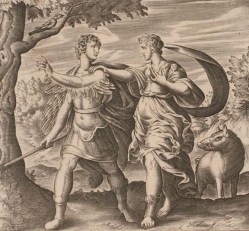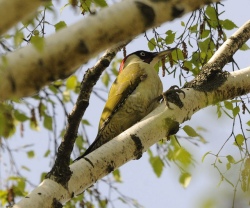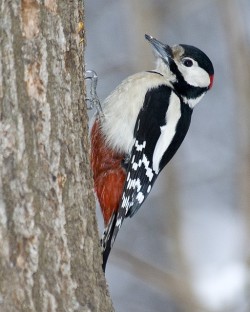Originally published April 2013
Hello everyone! As I sit here watching huge flakes of snow swirling around in the jaws of an easterly wind I can’t help but feel sorry for Ma Nature as she attempts to get her seasons in some sort of order. Nevertheless, despite the wintery blasts, our Fauna and Flora are battling against adversity and getting on with it. Trees are budding, leaves are unfurling and Wild Garlic and Spotted Orchids brave frostbite to push upwards through the snow. Bewildered birds are sheltering one moment, then feeding and nest-building the next, all whilst tuning up for the forthcoming Proms of the Avian world, the Dawn Chorus.
Let us continue our feathered theme and have our first show of hands this year. What type of bird provides us with some of the more unusual sounds of our countryside in Spring, was named after a Latin king and linked with two of the most insane and childish characters ever to grace our television sets? The latter refers to a 1940s american cartoon character and one (though any of them would fit the bill!) of the presenters of a certain programme involving three chaps driving an assortment of vehicles around various parts of the world, all the while insulting each other and locals alike. An easy one for all you birders, classicists and lovers of juvenile television; it is, of course, the Woodpecker.
As I cannot resist an opportunity to delve into the fabulous world of myth and legend, here is a tale typical of the genre; that is to say packed with love, jealousy and a fair spattering of therianthropy! Between the years 19 BC and 8 AD Publius Vergilius Maro and Publius Ovidius Naso (better known as Virgil and Ovid) built upon the sagas of Homer and wrote a number of eminent tomes.  One story described how King Picus of Latium spurned the love of Circe, familiar to us as the rather vindictive witch, nymph, or minor goddess (depending which translation you read) of Odyssey fame. She lived up to her reputation by luring him into a forest and turning him into a Woodpecker. Circe may well have been influenced in her choice of creature by the unfortunate king’s skill as an Auger, a religious official who fortold the future by studying, among other things, the flight of birds. This is not to be confused with an auger which, coincidentally, would have fitted the bill equally as well. The upshot of the nymph’s fit of pique was that Mars, the roman god of war and possible father of Picus, declared woodpeckers to be sacred and many of the birds were killed for their beaks which were sported by the Sandal’d and Toga’d Ones as lucky charms.
One story described how King Picus of Latium spurned the love of Circe, familiar to us as the rather vindictive witch, nymph, or minor goddess (depending which translation you read) of Odyssey fame. She lived up to her reputation by luring him into a forest and turning him into a Woodpecker. Circe may well have been influenced in her choice of creature by the unfortunate king’s skill as an Auger, a religious official who fortold the future by studying, among other things, the flight of birds. This is not to be confused with an auger which, coincidentally, would have fitted the bill equally as well. The upshot of the nymph’s fit of pique was that Mars, the roman god of war and possible father of Picus, declared woodpeckers to be sacred and many of the birds were killed for their beaks which were sported by the Sandal’d and Toga’d Ones as lucky charms.
 Today we have three members of the Family Picidae resident in the UK, all of them species of Woodpecker. Another member of the family, the Wryneck (Jynx torquilla), is a rare Autumn visitor. The largest of our Woodpeckers is the Green Woodpecker (Picus viridus), a bird you are very likely to see strutting around on your lawn in search of insects. Ants are their favourite food though various insects, nuts, seeds and even the eggs and chicks of other small birds make up their diet. Like a lot of the animals that are widespread throughout this country, the bird is known by a whole host of local names. Many of these pertain to its loud, hysterical call; the most common being Yaffle which probably dates from the 18th century and became used as a verb, to make a sound like a woodpecker (our misuse of nouns as verbs is not a modern phenomenon!). Traditionally the sighting of the bird is synonomous with the onset of rain and (unimaginatively) Rain Bird is yet another of its monikers. It is believed that Druids used Green Woodpeckers for divination, though quite how this was carried out is not recorded. If, like me, this conjures up an image of a bearded chap in animal skins holding two woodpeckers out at arm’s length and pacing up and down a field, then perhaps we all need a break!
Today we have three members of the Family Picidae resident in the UK, all of them species of Woodpecker. Another member of the family, the Wryneck (Jynx torquilla), is a rare Autumn visitor. The largest of our Woodpeckers is the Green Woodpecker (Picus viridus), a bird you are very likely to see strutting around on your lawn in search of insects. Ants are their favourite food though various insects, nuts, seeds and even the eggs and chicks of other small birds make up their diet. Like a lot of the animals that are widespread throughout this country, the bird is known by a whole host of local names. Many of these pertain to its loud, hysterical call; the most common being Yaffle which probably dates from the 18th century and became used as a verb, to make a sound like a woodpecker (our misuse of nouns as verbs is not a modern phenomenon!). Traditionally the sighting of the bird is synonomous with the onset of rain and (unimaginatively) Rain Bird is yet another of its monikers. It is believed that Druids used Green Woodpeckers for divination, though quite how this was carried out is not recorded. If, like me, this conjures up an image of a bearded chap in animal skins holding two woodpeckers out at arm’s length and pacing up and down a field, then perhaps we all need a break!
 The other family members to reside in our country are the Greater Spotted (Dendrocopos major) and the Lesser Spotted (Dendrocopos minor) Woodpeckers. The latter is the smallest and least common of the three. With its black and white markings and red crown it could pass for a juvenile D. major. However, the absence of a distinct red patch on the rump, which is specific to the Greater Spotted Woodpecker, makes identification easier.
The other family members to reside in our country are the Greater Spotted (Dendrocopos major) and the Lesser Spotted (Dendrocopos minor) Woodpeckers. The latter is the smallest and least common of the three. With its black and white markings and red crown it could pass for a juvenile D. major. However, the absence of a distinct red patch on the rump, which is specific to the Greater Spotted Woodpecker, makes identification easier.
Whilst strolling in the woods at this time of year our reverie is often interrupted by a burst of drumming, the likes of which would grace any Samba band. This is the Greater Spotted Woodpecker making its presence known, either for territorial purposes or to attract a mate. In order to do this they choose wood with the exact quality of resonance they require, often a hollow tree or even the side of a garden shed. Each Spring a new nesting hole is cut for breeding, depite the fact the birds will have over-wintered in a perfectly serviceable hole from the previous year. Woodpeckers normally choose decaying wood to nest in; this has the added bonus of having all the grubs and insects they can eat on their doorstep. Foresters often use the sight of woodpecker activity as an early warning to remove dying branches from a tree.
One sound we are highly unlikely to hear in our woodlands is the insane, laughing call of the american Acorn Woodpecker (Melanerpes formicivorus).  This is fortunate as the antics of the bird’s animated alter ego, Woody, would not be tolerated in our little reserve!
This is fortunate as the antics of the bird’s animated alter ego, Woody, would not be tolerated in our little reserve!
When drumming, a woodpecker moves its head at approximately 6m/second to strike the tree with a force in excess of 1000 times that of gravity. To prevent the bird from killing itself, or at the very least serious brain damage, woodpeckers have evolved with a number of safety mechanisms in situ. Unlike mammals, a bird’s tongue is rigidly underpinned by a cartilage and bone structure called the hyoid apparatus. In a woodpecker’s skull this apparatus is elongated to wrap itself up and over the brain to end in the nasal cavity of the bill. Not only does this provide protection to the brain, it leaves very little room for the organ to bounce around inside the skull. The tongue is long, sticky and often barbed. It can be projected forward with great force to penetrate ant nests or under loose bark to search for grubs.
The design of the woodpecker skull, with its ability to protect the brain under high impact stress, was adapted to construct the protective capsule demonstrated on the television programme Miracles of Nature. The programme’s adrenaline-driven presenter took a break from driving up and down mountains to test how effective the design is by taking it up into space and dropping it with a light bulb inside. It is beyond me why they had to go so high to drop the capsule but the bulb remained intact as did the reputation of the woodpecker, not that that was ever in question!
So there it is, a very brief explanation as to why the mellifluous strains of our dawn chorus are punctuated regularly by the sounds of maniacal laughter and frantic drumming. Listen and enjoy!
The Wood-pecker whose hardned beake hath broke,
And pearc’d the hart of many a sollid Oke.
Michael Drayton 1604
Any thoughts to pgcrow@yahoo.com
Paul Johnson
Images: Green Woodpecker & Greater Spotted Woodpecker by Sergey Yeliseev used under Creative Commons License 2.0